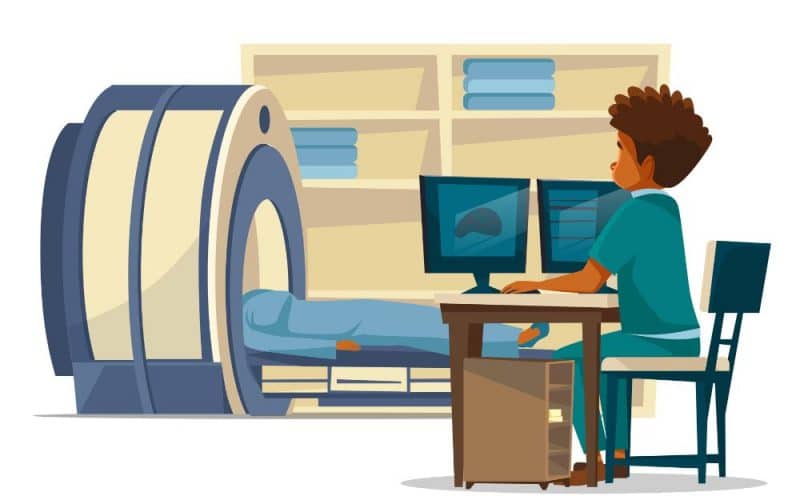A magnetic resonance imaging (MRI) technologist helps support patients with medical needs while working with sophisticated scientific technology. MRI techs are among the higher-paid professions within the allied health industry, which is the industry involved with identifying and analyzing medical conditions.
People with an interest in providing health care, working directly with patients or taking scientific images may want to consider becoming an MRI tech.
The U. S. Bureau of Labor Statistics (BLS) reports that as of 2020, the median salary for MRI and radiologic technologists of all types was $63,710 per year. Median salary means that half the people in the occupation earned more, while half earned less.
Employment website ZipRecruiter reported an average MRI technologist salary of $75,550, with earnings ranging from $40,500 to $106,500.
Who is an MRI Technologist?
An MRI technologist uses magnetic resonance imaging (MRI) technology to take pictures inside the human body for diagnostic purposes. MRI technologists work in health care facilities, such as hospitals and clinics, where they provide patient care and conduct MRI scans that produce internal imagery of the human body using a combination of radio waves and powerful magnetic fields.
MRI technologists are critical to diagnosing internal conditions, such as brain tumors, infections, and anomalous brain activity like that resulting from strokes, Alzheimer’s, and dementia. Some of the most common duties MRI techs perform include:
- Maintaining imaging equipment
- Preparing patients for MRI scans
- Working with physicians to identify where patients should be scanned
- Operating imaging equipment during scans
- Maintaining relevant patient records
What is an MRI?
An MRI machine is a type of medical equipment that performs examinations on the human body using a computer, magnets and radio waves to show two- and three-dimensional images of internal organs, bones and tissues. MRI exams may take anywhere between 15 and 90 minutes to perform, depending on how many images an MRI technologist needs to take.
MRI equipment typically resembles a large magnet or tube and requires the patient inside to lie still while the exam is in process.
Understanding the role of an MRI technologist
As a crucial member of the healthcare team, an MRI technologist is responsible for operating and maintaining MRI machines used for various medical procedures. They work closely with radiologists and physicians to perform diagnostic imaging exams on patients accurately and efficiently.
To become an MRI technologist, one must have a high school diploma or GED and complete an accredited MRI technology program, which typically takes 1-2 years to finish. Additionally, MRI technicians must obtain certification from the American Registry of Radiologic Technologists (ARRT) or other professional organizations to practice in their field.
As a highly skilled role, the salary expectations for MRI technologists are usually above average. According to the Bureau of Labor Statistics, the median annual salary for MRI technologists was $73,410 as of May 2020. However, the salary range may vary depending on factors such as location, experience, and education level.
Additionally, some MRI technologists may work in specialized fields such as cardiac or pediatric imaging, which may offer higher salaries. Others may opt to pursue supervisory roles or take on additional responsibilities, which can also lead to increased pay.
Overall, the job prospects for MRI technologists are promising, with a projected growth rate of 7% from 2019-2029, which is faster than the average for all occupations. As the healthcare industry continues to expand, the demand for MRI technicians is expected to increase, resulting in more employment opportunities and potentially higher salaries.
What does an MRI technologist do?
An MRI tech operates an MRI scanner on patients, typically at a hospital or clinic. They talk through the MRI procedure as it happens to help patients know what to expect. Other responsibilities of an MRI tech include:
- Positioning patients in a way that allows for photographing clear images
- Following the requesting physician’s directions about the type of images needed
- Moving image parameters during the scan to improve image quality
- Helping patients stay relaxed during the MRI procedure
- Giving patients contrast media through IVs to enhance image visibility
- Assisting physicians in examining the images to figure out diagnoses
MRI Technologist salary and job outlook
The average annual salary for an MRI technologist in the United States is $89,889, according to Indeed. Salaries for MRI techs vary depending on many factors, such as years of experience, geographic region and place of employment.
According to ZipRecruiter, while there are weekly salaries as high as $3,154 and as low as $779, the majority of MRI technologist salaries currently range between $1,605 (25th percentile) to $2,596 (75th percentile) across the United States. The average salary range for a MRI technologist varies greatly (by as much as $990), which suggests there may be many opportunities for advancement and increased pay based on skill level, location, and years of experience.
The U.S. Bureau of Labor Statistics predicts that job opportunities for MRI techs may increase by 7% by 2030, which is a greater increase than most professions. This projected increase in MRI tech jobs is in part because of an expected increase in medical issues, such as dementia or cancer, that use diagnostic imaging.
MRI technologist salary by state
| State | Annual Salary | Monthly Pay | Weekly Pay | Hourly Wage |
|---|---|---|---|---|
| Washington | $128,884 | $10,740 | $2,478 | $61.96 |
| Delaware | $120,723 | $10,060 | $2,321 | $58.04 |
| Virginia | $118,645 | $9,887 | $2,281 | $57.04 |
| Maryland | $116,834 | $9,736 | $2,246 | $56.17 |
| New York | $116,687 | $9,723 | $2,243 | $56.10 |
| Vermont | $114,280 | $9,523 | $2,197 | $54.94 |
| Nebraska | $114,102 | $9,508 | $2,194 | $54.86 |
| Oklahoma | $110,500 | $9,208 | $2,125 | $53.13 |
| California | $110,327 | $9,193 | $2,121 | $53.04 |
| Massachusetts | $108,978 | $9,081 | $2,095 | $52.39 |
| Alaska | $108,012 | $9,001 | $2,077 | $51.93 |
| Maine | $107,467 | $8,955 | $2,066 | $51.67 |
| Pennsylvania | $106,882 | $8,906 | $2,055 | $51.39 |
| Oregon | $106,533 | $8,877 | $2,048 | $51.22 |
| North Dakota | $106,488 | $8,874 | $2,047 | $51.20 |
| Idaho | $105,750 | $8,812 | $2,033 | $50.84 |
| New Jersey | $105,686 | $8,807 | $2,032 | $50.81 |
| Texas | $105,230 | $8,769 | $2,023 | $50.59 |
| Colorado | $104,542 | $8,711 | $2,010 | $50.26 |
| Hawaii | $104,500 | $8,708 | $2,009 | $50.24 |
| Wisconsin | $104,408 | $8,700 | $2,007 | $50.20 |
| New Hampshire | $104,090 | $8,674 | $2,001 | $50.04 |
| Wyoming | $102,167 | $8,513 | $1,964 | $49.12 |
| Nevada | $102,130 | $8,510 | $1,964 | $49.10 |
| South Dakota | $100,643 | $8,386 | $1,935 | $48.39 |
| Indiana | $100,617 | $8,384 | $1,934 | $48.37 |
| Minnesota | $100,547 | $8,378 | $1,933 | $48.34 |
| New Mexico | $100,298 | $8,358 | $1,928 | $48.22 |
| Rhode Island | $98,675 | $8,222 | $1,897 | $47.44 |
| Arizona | $98,537 | $8,211 | $1,894 | $47.37 |
| Ohio | $97,822 | $8,151 | $1,881 | $47.03 |
| Montana | $97,053 | $8,087 | $1,866 | $46.66 |
| Connecticut | $96,453 | $8,037 | $1,854 | $46.37 |
| Illinois | $96,432 | $8,036 | $1,854 | $46.36 |
| Iowa | $95,929 | $7,994 | $1,844 | $46.12 |
| Alabama | $95,840 | $7,986 | $1,843 | $46.08 |
| Mississippi | $95,614 | $7,967 | $1,838 | $45.97 |
| Tennessee | $93,393 | $7,782 | $1,796 | $44.90 |
| Utah | $93,322 | $7,776 | $1,794 | $44.87 |
| Missouri | $93,125 | $7,760 | $1,790 | $44.77 |
| South Carolina | $92,165 | $7,680 | $1,772 | $44.31 |
| North Carolina | $90,262 | $7,521 | $1,735 | $43.40 |
| Kansas | $90,022 | $7,501 | $1,731 | $43.28 |
| Georgia | $89,283 | $7,440 | $1,716 | $42.92 |
| Louisiana | $87,787 | $7,315 | $1,688 | $42.21 |
| Michigan | $86,633 | $7,219 | $1,666 | $41.65 |
| Kentucky | $86,554 | $7,212 | $1,664 | $41.61 |
| West Virginia | $82,546 | $6,878 | $1,587 | $39.69 |
| Arkansas | $82,288 | $6,857 | $1,582 | $39.56 |
| Florida | $79,015 | $6,584 | $1,519 | $37.99 |
How to become an MRI technologist
Typically, MRI technologists are required to have an associate degree in a related field of study like an Associate of Science in MRI Technology. Depending on the program, some degrees might even lead into a bachelor’s program.
While some recent graduates might be able to get an entry-level MRI technologist position upon graduation, many employers prefer to hire those with previous experience in a related field like radiologic technologist. Depending on the state, MRI technologists may also be required to be certified or licensed to practice professionally.
Here are six steps to help start your career as an MRI technologist:
Get an associate degree
Most MRI programs and certifications require an associate’s degree. Students may study any field for their associate degree. Most aspiring MRI technologists decide to major in biology, anatomy, physics or a related subject.
Enroll in an MRI tech program
MRI certification programs require candidates to first complete an MRI tech program. Aspiring MRI technologists should apply to an accredited MRI program. Accreditation organizations include the American Registry of Magnetic Resonance Imaging Technologists (AMRIT), the Joint Review Committee on Education in Radiologic Technology (JRCERT) or the Commission on Accreditation of Allied Health Education Programs (CAAHEP).
MRI tech programs typically combine traditional academic instruction with direct training in MRI procedures and tools. Students take classes in MRI physics, cross-sectional anatomy, patient care procedures, MRI image analysis and related subjects.
Gain clinical experience
MRI clinical experience allows aspiring MRI technologists to gain actual work experience in a clinic or hospital. Some students may receive a clinical apprenticeship as part of their MRI program, while others might seek clinical experience on their own. Clinical apprenticeships give individuals the opportunity to work alongside a real MRI technician and further develop their skills.
Get certified
All MRI technologists need to receive certification from a legitimate organization. Certification from the American Registry of Radiologic Technologists (ARRT) is most common. However, ARMRIT also awards MRI certifications. Professionals can pursue this certification after completing an MRI tech program and earning work experience.
Receive a state license
Some states require MRI technologists to receive licenses. Be sure to research the legal requirements in your particular state before you apply for MRI jobs.
Pursue more education or certifications
MRI technologists interested in advanced or supervisory positions should consider further professional development opportunities. Some individuals may decide to take classes and get certifications for other types of medical technician roles, such as sonography or radiography. Others might choose to earn a bachelor’s or master’s degree in radiologic technology, chemistry, nuclear medicine technology, imaging sciences or a related field.
Certifications for MRI technologists
Here are a few certifications an MRI technologist can receive and the process:
American Registry of Magnetic Resonance Imaging Technologists certification
MRI technologists can receive a certification from ARMRIT after graduating from an ARMRIT program, completing the MRI clinical training and passing the ARMRIT exam. Obtaining an ARMRIT certification can improve an MRI technologist’s chances of getting a preferred position with the company of their choice. This certification requires a renewal process every three years, which comprises continuing education in MRI technology or patient care.
American Registry of Radiologic Technologists certification
An eligibility requirement to get an ARRT certification is to complete a degree program from an ARRT accredited institution. If a candidate meets this requirement, they can take the ARRT certification exam. Getting this certification may boost a candidate’s chances of securing a job with certain employers that require more than general MRI knowledge. After the initial certification, it’s important to remember to take the recertification exam every two years to stay up to date on the processes and protocols.
Joint Review Committee on Education in Radiologic Technology certification
An accredited institution may provide a JRCERT program that can take up to two years to complete and may require attending clinical courses and completing pertinent assignments. After completing a JRCERT program, an individual might expect to have skills in using radiation protective equipment and MRI equipment, basic medical practices and patient care procedures.
Recommended Articles
- Social Media Manager Salary: How Much Do They Make in 2024?
- 20 Reasonable Personal Reasons To Call Off Work
- Staff Software Engineer: Who Are They & What Do They Do?
- Dentist Salary: How Much Do Dentists Earn Per Year?
- Average Car Salesman Salary in the United States 2024
- How to Become a Notary Public in Georgia: 2024 Guide






